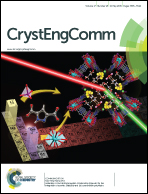The structure of monoclinic Na2B10H10: a combined diffraction, spectroscopy, and theoretical approach†
Abstract
Neutron powder diffraction measurements of a specially synthesized Na211B10D10 compound, buttressed by comparative measurements and calculations of vibrational dynamics, have led to an improved, Rietveld-refined, structural model for its low-temperature monoclinic phase. The detailed atomic arrangements and phases for this compound are important for an understanding of its potential roles for fast-ion-battery and hydrogen-storage applications. A comparison of the calculated phonon densities of states (PDOSs) based on density functional theory for both the previously published structure and our new modified structure show that the PDOS of the latter is in noticeably better agreement with that experimentally observed by neutron vibrational spectroscopy. Moreover, this improved structure is predicted to have a higher stability and exhibits more reasonable separations between all neighboring sodium cations and decahydro-closo-decaborate anions. These results demonstrate the effectiveness of combining first-principles computational methods and neutron-based structural and spectroscopic techniques for determining crystal structures for such complex hydrogenous materials.


 Please wait while we load your content...
Please wait while we load your content...